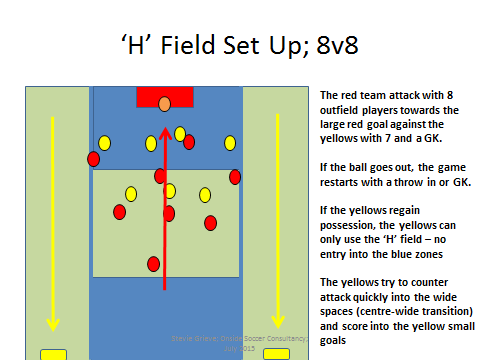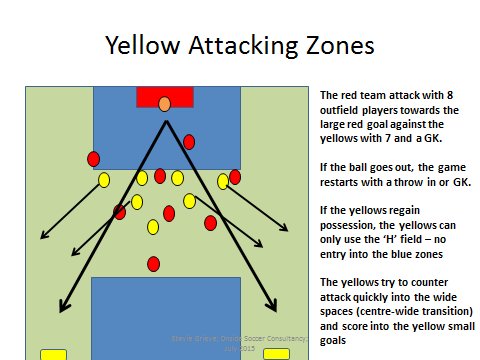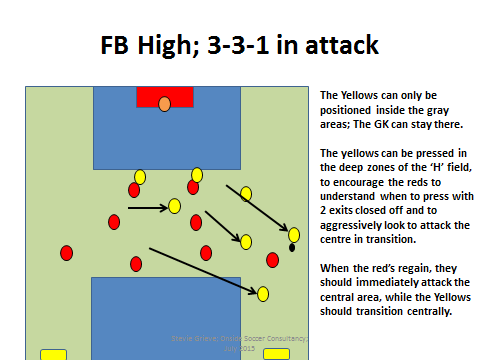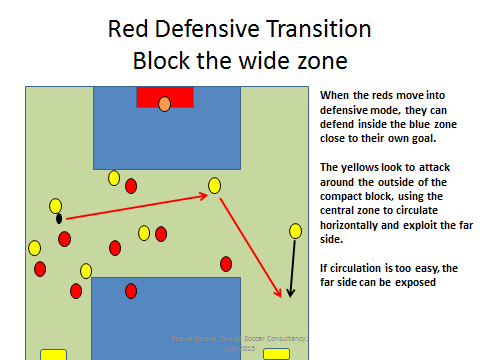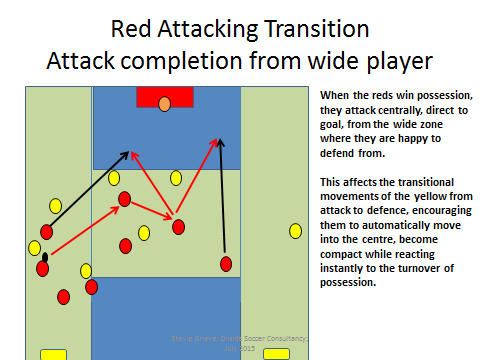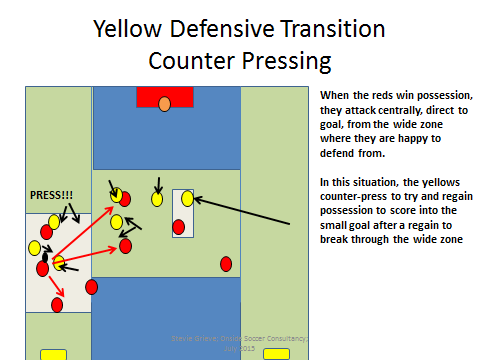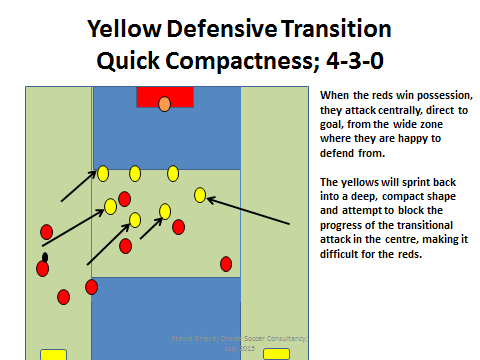Tactical Theory: Using different shaped fields to work on specific objectives
As a coach, we are often looking for ways to improve the speed of the attacking and defensive transitions our teams make, and as our training sessions have specific objectives, we must ensure that our players are as well prepared as possible to be able to overcome the threats the opposition may offer us. How do we reach the objectives we are looking for?
DIFFERENT SOLUTIONS FROM THE TRADITIONAL WAYS?
One way is to plan specific excersizes which will allow players to naturally reach the objective of the session, with some coaching help made along the way if the players are struggling to come up with the best solution to reach the objective of the session.
A different way to reach these objectives can be to simply change the dimensions of the field, which alters the way players can behave and make specific choices, for example:
If you play against an opponent who like to attack centrally and via zone 14 with intricate play (zone 14 is the most strategically important zone of the field and the area UEFA concluded was the zone where most goals and assists came from), we would naturally want to control centre defensively and maybe play in a low block if the opponent have pace to get behind the defence, giving more space behind the opposition to counter attack into.
If we work on controlling the centre defensively, we would naturally want to counter attack into the spaces on the side, which would in turn effect the opponent would need to alter their starting positions and movement patterns in order to not only control the transitions of the attack to the wide area, but to make sure enough players can recover if the counter attack to the wide zone isn’t stopped.
Obviously, when we counter attack, we don’t want to ‘over-commit’ by sending more than 5 players to the counter attack, as we would not want to be ‘counter-countered’ by a team who are quick in transition themselves.
If we target the wide areas in the counter attack, the width will need to be provided by either the wingers, wide moving centre forwards, outside central midfielders or full backs, meaning that other players will have to make compensation mechanisms to cover the vacant spaces left by attacking runs to cover incase of a turnover of possession and new counter attack form the opposition. With this in mind, we need to look at different movement patterns when various players make the forward run;
For example, if the Left Back was to make the wide run, what would the right back do? If the right back opens up wide (both full backs in zones 1 and 5; the widest zones on the field vertically) then the far side full back may find trouble recovering centrally to get back into defensive shape if the ball is lost.
Does the right back tuck in as the play is opened up on the left to maintain a compact position in the pre-transition phase? Would the Right back staying inside impact the position of the right central midfielder and how would this impact the overall attacking structure?
If the Left Back moves forward, does the left central midfielder shuttle over laterally and cover the space behind, with the centre backs moving over as a result?
If the striker was to drift wide and offer the outball, would the far side central midfielder move onto the last line to stretch the play and leave cover behind the ball in a stable position? Would this mean that the left back stays deep in a supporting role, in a stable position in pre-transition?
HOW WE CAN ALTER THE FIELD SHAPE OR DIMENSIONS TO ALLOW US TO WORK ON POSITIONING FOR TRANSITIONS?
As we can see, the field is a normal 60×60 yard field, suitable for 8v8 or 9v9.
As wthe red team are a central attacking based, intricate team moving to attack centrally and an aggressive counter-pressing team, they will play inside the narrow 30×60 yard strip down the middle, with the yellows attacking the 2 small goals on the outside channels (1 & 5)
Notice the field is in an ‘H’ shape; this is to clearly define the central attack v wide transition attacks of both teams. No Yellows will be allowed inside the blue zones in possession – the central channel can be used to circulate play and switch flanks to open the field, while the reds will transition instantly to attack the open centre.
Obviously, the yellow team will have the 2 centre backs still in the centre to cover behind the play, and likely 1 of the 3 central midfielders, leaving 4 back (including the GK) behind the ball.
As we can see, the yellows will quickly break towards the outside and attack the small goals; this will cause the red team to tilt, drop and cover to stop the advance to the small goals on the outside if the counter-press is beaten.
If the FB is the outlet, the far side FB tucks in to make a back 3 behind the ball, the far side CM tucks over between the CBs, while the near side CM supports in the channel. The CF offers a pass behind.
As a result of the field shape and attitude of the yellow team, the red will quickly have to shift to cover the ball side, which if they stay compact, can slow down the yellow counter attack. This may leave them vulnerable if the far side player doesn’t match the run of the far side attacker.
Both teams are allowed inside the blue zone to make runs across the field but only the reds can receive (as this is the central attacking area designated for them.)
As the reds regain possession, the yellows are too open and can be exploited centrally due to a lack of compactness in the pre-transition phase. We need to ensure that in possession, we maintain compactness and don’t allow the opposition to break through centrally in transition.
If we are a team who have been coached to counter press, we may have some issues against a direct attacking team who can evade the press with quick forward passes; in this instance the 2 players closest to the ball can press and block the forward passing angles, with the players in deeper area away from the ball able to read and intercept passes, or even play-man to man and discourage a pass. The far side FB who stayed in a narrow position can move into a compact defensive shape quickly, and avoid being exploited from a run by the central midfielder if they were to start from a wider position.
If the team we are playing against are a particular threat with direct penetration on the attacking transition, our team may simply withdraw, block up the centre and start again in an organised defensive shape, allowing the attack back into the centre but where the space is reduced.
CONCLUSIONS
I feel that when we set out our playing strategy for our teams, we need to look beyond the normal and traditional coaching methods and look for new ways to educate our players to be able to play the game in a more thoughtful, intelligent way, and changing the field shape may allow the players to understand better the ideas of the coach, and how we can implement ideas which can have specific objectives in all 4 phases of the game that can be reached via the training excersizes provided.
* Stevie Grieve is a football analyst, Head of Coaching at BBFS.

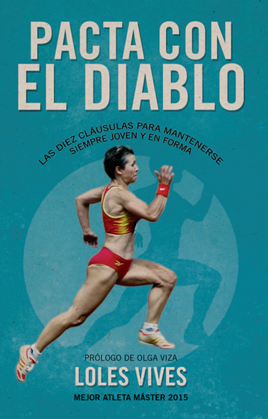
BUSCADOR DE CATEGORÍAS
BUSCADOR POR MES
ÚLTIMOS TWEETS
Tweets por @martiperarnauSÍGUENOS EN FACEBOOK




